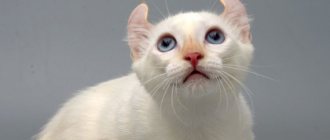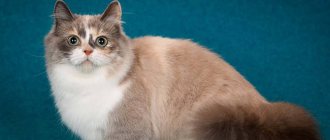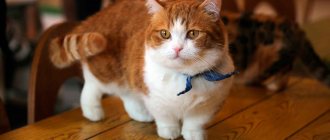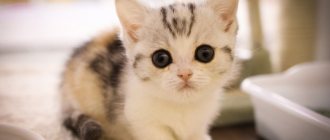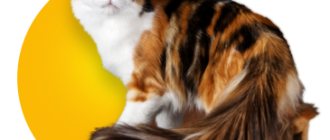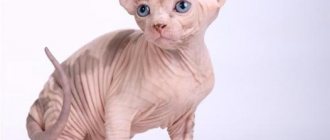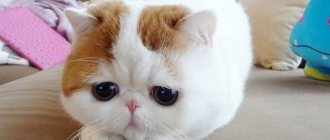Care and maintenance
Who is the most curious cat?
This breed is easy to maintain and does not require special care. Experts recommend following a few simple rules.
- Despite the sociable nature of cats, they love to “build nests” in order to feel protected while resting. Provide the munchkin with a basket, small sturdy box, or other house with soft bedding.
- Buy a deep tray, since clean pets actively bury waste and can litter around.
- It is enough to comb short-haired munchkins once a week, and 2 times a week for long-haired munchkins. The main thing is to prevent tangles from occurring.
- It is enough to bathe these cats once every 3-4 months with special shampoos.
- Changing claws is usually easy for munchkins, especially if there is a scratching post in the house. Once every 2-3 weeks it is worth checking the condition of the paws in order to help the pet if necessary.
- You should clean your ears not deeply and very carefully, about once a month.
- It is not advisable to let cats go for walks on their own, as a squat animal often looks like it is preparing to attack, which may be misunderstood by other pets or people. Due to the short legs, the munchkin can be injured.
- Munchkins should be fed in moderation because, despite their high mobility, they are prone to obesity. Provide frequent replacement of drinking water and adequate nutrition.
- By using special toothpastes once a month, you can successfully prevent the development of oral diseases in munchkins.
Yum-yum
As for nutrition, it is not recommended to feed your cat from a common table. Use specialized or separately prepared natural foods. These types of food should be alternated, but not mixed in one plate. Do not buy cheap food as it is similar to fast food for humans. Are you planning to cook food for your munchkin at home? Experts advise preparing your diet this way:
- 60% – raw or boiled meat (rabbit, beef, offal);
- 30% – boiled or raw vegetables;
- 10% – porridge.
Munchkins should not be treated to salty, sweet, fried, smoked, bean dishes, fish, or fatty meats (lamb, pork). An adult cat can be fed a couple of times a day, kittens - up to 6 times a day.
How to choose a kitten
Munchkin kittens are usually ready to come to a new home after they reach two months, by this age they eat independently and are able to live without their mother.
Since the Munchkin breed is still very young, there are not very many nurseries specializing in breeding Munchkins.
This means that there is practically no chance of buying a purebred animal. The cost of a kitten is quite high, especially if you purchase a short-legged pet.
The fact is that in each litter only half of the kittens are born with short legs.
Kittens with long legs are no different from their littermates, and also receive documents and can participate in matings with short-legged individuals.
Munchkins are not jealous, affectionate and love to sleep with their owners.
The kitten should not have:
- Curvature of paws;
- A twisted or broken tail;
- Dull, tousled fur;
- Discharge from the eyes;
- diarrhea or vomiting;
- Large, swollen belly.
The colors of munchkins, as well as the length of the coat, are not important, since within the breed there is a huge variety of colors and two types of coat: short and long.
You should not buy a very small kitten, since according to the standard they should not be dwarfs, with a very small chest volume.
Munchkin is a breed that attracts with its appearance
The Munchkin standard does not allow cats that show any signs of disobedience or aggression to be bred; this must be taken into account when choosing a kitten.
Kittens that are too shy and unsociable should not be adopted.
Munchkin. Photo
The Munchkin is a short-legged cat that looks like a character from a fairy tale. They even owe the name of the breed to fairy tales. The word munchkin was first found in the book “The Wizard of Oz”, as it symbolized the beginning of an era of goodness and love, just like munchkin cats do today.
https://youtu.be/E_ScT8rHxPw
Breeding
An unusual fact in the development of long-haired and short-haired forms of the breed is crossing with non-pedigreed cats. As a result, the solid color is less common compared to the tabi color.
When munchkins mate with each other, all kittens have short legs. But in the first generation, when munchkins mate with ordinary cats, there are no results.
Until recently, it was difficult to purchase a munchkin kitten in Russia. Today you can buy a purebred pet from a breeder in almost every major city in the country.
Thus, there are several nurseries in Moscow, the largest of which are Sunny Fairies and Murmulet; you can also apply for a kitten at Super Munchkin, which is located in St. Petersburg.
In addition, kittens with a pedigree are sold in the Iberis nursery in the city of Magnitogorsk and in similar organizations in Tyumen, Kaliningrad, and Yekaterinburg. Due to the fact that kittens sell out quickly, the animal can be reserved in advance.
Kittens from nurseries are sold only after castration or sterilization, in order to prevent mating with other animals, as this is harmful to the development of the breed.
If the presence of a pedigree is not important for future offspring, then a mating partner is found from among ordinary cat owners. It is important that the partner does not have a dominant gene responsible for the appearance of short legs
Cost of a munchkin cat in Moscow and throughout Russia
The Munchkin breed still remains relatively rare in our country, and a rare product does not come cheap. Here are some examples of prices from leading Russian nurseries:
- “Murmulet” (Moscow) - 40,000–50,000 rubles;
- Supermunchkin (St. Petersburg) - 27,000 rubles;
- Sunny Fairies (Moscow) - 25,000–30,000 rubles.
In regional nurseries, the cost of a purebred munchkin is approximately the same as in Moscow - 20–40 thousand rubles. It should be taken into account that resolving delivery issues also, as a rule, falls on the shoulders of the buyer (about another 5,000 rubles).
It is worth noting that the indicated prices apply to cats and cats for castration, and specimens approved for breeding will cost more, and breeders do not sell them to everyone.
A kitten for castration is not a marriage
For those who get a purebred pet for the first time, this fact often raises doubts and questions: why is the kitten sold for castration or already neutered? Does this mean I am buying a breeding match?
In reality, there is no question of any marriage. The animal is castrated (or a clause about this is written in the contract) so that the buyer does not engage in uncontrolled breeding of cats. Why? The point here is not only and not so much about competition (although it cannot be done without it).
The position of felinologists is this: only a professional who has undergone special training has the right to engage in breeding. In addition, by breeding “half-pedigreed” pussies without documents, unfortunate breeders sell them at the lowest prices or cannot sell them at all and place them in “good hands” for free.
If the hands are not very kind, the animal ends up on the street and dies.
Breed characteristics
Short legs are the result of a gene mutation that did not affect the spine and the formation of the back. The spine has retained its shape, so munchkins have the same flexibility as other cat breeds.
- The shape of the body is elongated, with well-developed muscles. Outwardly they look a little like dachshunds.
- Adults grow about 15 centimeters in height, weighing from 2 to 4 kilograms.
- The hind legs are slightly longer than the front legs.
- The neck is small, wide and muscular
- The paws come in three varieties in length and have the following names: “standard”, “short” and “rag hugger”. The last ones are the shortest of all possible ones. The paws are quite wide and with such growth they look very massive and have a rounded shape. Slight curvature of the forelimbs is allowed.
- The tail is quite thick and looks proportional to the size of the body.
- The head is small but wide and wedge-shaped. Round back of the head and not particularly pronounced wide chin.
- The ears are medium in size and have a round shape.
- The eyes are quite large, round and almond-shaped options are allowed. The eye color is usually rich; there are cases when the eyes are of different colors (for example, one eye is green and the other is blue).
- Munchkins have both long and short hair; according to the standard, the breed is considered semi-long-haired. The color can be any, all possible combinations of colors and patterns are allowed.
The munchkin cat has another interesting feature - it loves to stand on its hind legs, pressing its front legs to its body. This looks very unusual and is typical only for cats of this breed.
https://youtube.com/watch?v=52fPZRNX4zQ
Character of short-legged cats
This breed of cats is friendly and playful.
The most important thing for them is attention; the munchkin cat has a hard time withstanding loneliness. A pet of this breed will try by any means to be played with, caressed, stroked and hugged.
Munchkins get along well with children, but the child must know how to behave with the animal so that they do not harm each other. Many people note that short-legged cats are smart enough to follow commands, so you can spend some time training and teaching some commands.
Cats of this breed are very sociable and always welcome guests. They get along quite well with other pets. Moreover, it is more difficult to get along with cats than with other pets, for example, dogs.
They are absolutely not aggressive, but when it comes to self-defense, they can stand up for themselves. Quite active and mobile, they love to walk in the fresh air. They run quickly and jump well, deftly climb high furniture and curtains, so from the first days kittens should be taught order.
They respond well to training; there are usually no problems with litter box training. They are patiently able to endure a long move or transportation. They settle into a new place quite quickly.
Personality of Munchkin cats
Munchkin cats have quite a special character. Due to the fact that their short legs do not allow them to fully hunt, these animals cannot live on the street. Once in a house or apartment, these pets begin to bring pleasure and joy to the owner from the very first minutes of their stay here.
Short limbs do not allow these pets to climb onto tables, break expensive vases and valuable figurines, however, they do not prevent them from being active in relation to everything that is located below - these cats run great, they only have problems with jumping. In addition, they incredibly like to take the so-called “kangaroo” position - sitting on their hind legs, using their tail as support. All munchkins adore this pose, which is confirmed by the presence of many munchkin photos on the Internet.
With all this, their small front paws just hang on the sides, so the photo turns out very funny.
The dachshund cat also loves to hide objects, which the owners will then search for for a long time. Munchkins like to find small objects and take them to the most secluded corners of the apartment.
In general, the temperament of cats of this breed is quite calm and friendly. They have no difficulty meeting new people, they have no neuroses, they love to move, show curiosity and kindness towards others. This fact was noted in the reviews of Munchkin cat left on the Internet.
Due to their disposition and exterior, munchkin cats are suitable pets for lovers of everything exotic, for those who love smart animals, as well as for large and friendly families. In such a company, such a pet can easily nullify any manifestations of aggression or boredom.
Veterinary
All the many advantages of munchkins - both their external charm and wonderful character - fade into the background if the animal is unhealthy
It is important not only to choose the right pet for yourself that is strong and disease-resistant, but also to constantly maintain it in optimal physical shape. And here a lot depends on the owner - on proper maintenance of the cat at home and qualified veterinary care
Breed defects and diseases
Munchkins who lead a sedentary lifestyle are at risk. At the same time, against the background of regular overeating, such an unpleasant and dangerous disease as lordosis can develop. Burdened with excessive loads, the spine bends beyond measure, internal organs are subjected to pressure and even deformation. To avoid pathology, you just need to promptly provide the animal with a normal diet and physical activity, and also visit a veterinarian from time to time for preventive examinations.
Pay close attention to your pet's posture
Care
Despite their unusual appearance, munchkins do not require any special care.
Grooming
Grooming is slightly different depending on whether you have a long-haired or short-haired pet in the home.
Short-haired munchkins do not require serious grooming, but their appearance will certainly benefit from regular brushing and removal of dead hair, and subsequent polishing with a suede cloth will give the coat a special shine. For combing, it is best to use brushes made of natural short bristles, fine-toothed combs or special rubber mittens. It will be quite enough if this procedure is carried out once a week, and during seasonal molting twice a week.
Long-haired cats can be brushed at least every day, but this must be done two to three times a week. Combing will prevent the formation of tangles, reduce the amount of hair that the cat swallows when licking, speed up shedding and of course improve its appearance. To comb long-haired cats, various devices are used: massage combs, slicker brushes, rubber gloves, combs, furminators, and natural bristle brushes. Usually the owners themselves choose what is more convenient for them to work with.
Bathing
You should not bathe your munchkin often; this is done only as needed, usually two or three times a year, when the fur becomes greasy and requires additional washing, and also after shedding. Munchkins are not fans of water procedures, but in most cases they behave quite calmly. After bathing, it is better to pat wet wool with a towel and let it dry on its own. The hair dryer can be used when the fur coat is almost dry. Otherwise, overdried hair will become dry and brittle. In addition, intense drying can negatively affect the condition of the skin.
It is not recommended to bathe munchkins more than once every 5 months, but you can brush their fur regularly. Hygiene products, shampoos and conditioners are selected taking into account the length of the cat's fur.
Hygiene of the oral cavity, eyes and ears
It will be great if your baby munchkin can be trained to brush his teeth from an early age and carry out the procedure at least once a week using special veterinary pastes and a soft toothbrush. Brushing your teeth will prevent the formation of plaque and tartar. The eyes and ears are regularly inspected for contamination and cleaned as necessary.
Nail trimming
In this matter, everything is individual. If the cat is accustomed to the scratching post, does not spoil things and does not scratch, then it does not need a manicure. If there is such a need, then the claws are trimmed with special tweezers to literally 1-2 mm. It is worth considering that they grow back very quickly and become sharp again even faster; after 1-2 weeks the procedure will have to be repeated.
Munchkin cats are easy to care for and can handle this task on their own. As mentioned above, they are neat and clean. But still give your love to the cat - she will thank you for it with her devotion.
Reviews about munchkin cats
- Tatiana.
You can read all the necessary information about munchkin porridges on the Internet. However, if you see this incredible creature in person, you will remember this moment for a long time. I consider their inability to jump high to be a significant advantage, because you don’t have to worry about the safety of everything that is stored somewhere on high shelves.
Munchkins are such small, calm and friendly animals, ideal pets for a standard city apartment. They communicate well with all people, including small children. You shouldn’t think that they immediately rush into the arms of all strangers who come into the house, but after the animal takes a closer look and sniffs, it will make contact.
Kittens of this breed are terribly cute, such affectionate purring little lumps.
https://youtu.be/C78qYrTvbN0
In some places they write that due to their structure there is a strong load on the spine, but I did not notice this. They have strong, massive limbs that support their small body well, the main thing is not to overfeed the animal!
I have two magnificent munchkin cats; I don’t know any more gentle creatures. The cat who lives with her mother is also a renowned healer. When mom has a headache, she lies down next to her, if her heart hurts too, and after a while everything goes away.
Overall, these are very sweet, humble and kind animals that are guaranteed to save you from stress and depression. I recommend!
I present a photo of my munchkins .
- Marina.
The Munchkin is a cat breed. These cats are also called dachshunds because of their short legs, which give them a resemblance to these dogs. I fell in love with this breed almost immediately. These short-legged cats love to sit, especially when they need to beg for something. Extremely cute and friendly creatures.
I want to give advice. If you have an animal of this breed at home, remember that the peculiarity of their structure creates a fairly large load on the spine. For this reason, the cat needs to be constantly monitored. If she lies down too often, most likely. Her back hurts.
Munchkin: advantages and disadvantages of the breed
- The short-legged cat has a special body structure - squat, elongated. A cat's paws are 2 or even 3 times smaller than the paws of ordinary cats. The mutations did not affect the ridge, therefore, the animal retained its natural body shape, as well as its size. The internal structure of the pet has not changed. Low paws enable cats to be constantly active, mobile, and lively.
- The average weight of a cat of this breed is 4 kg. The female is slightly smaller than the male, weighing no more than 3 kg. The pet's body is slightly elongated, strong, and also muscular. The legs located at the back are longer than the front ones. They are straight, there are no curvatures.
- There are round pads on the paws. When a cat moves, its claws click. The pet's tail is elongated. During movement, especially for young individuals, the tail is held vertically and wags slightly. The animal moves gracefully, even smoothly.
Little paws
- The animal's head is round and proportional to the body. The outline of the head is similar to a wedge. The cat's nose has a slight deflection, but this is not a defect. The Munchkin's ears are wide at the base and have rounded tips. Cats with long hair have tufts on their ears.
- A cat's fur comes in different lengths. The structure of the animal's fur is silky, dense, and pleasant to touch. The munchkin with long hair has a chic collar around his neck. But short-haired breeds are very similar to plush toys.
- Cats come in a wide variety of colors. There are animals that are red, gray with a blue tint. There are pets with spots and stripes.
The disadvantages of the breed include the following:
- Having curly hair.
- Sagging back.
- Protruding bone on the chest.
- Round head.
- Uneven foot fit.
- The animal is good-natured and curious. People who have these pets feel as if they are from another world. It cannot be strictly stated that munchkins have the same character. The pet's temperament will depend on genes, therefore, each representative has its own character. But in general, such animals are considered quite groovy. They get along well with people.
- Individuals of this breed love frisky games. Short legs do not prevent cats from being nimble: pets can quickly jump onto low tables, chairs, sofas and other furniture. Cats also love curtains and attack them regularly.
- Of course, a cat won’t be able to jump very high, but he can steal some tasty dish from the table by first jumping onto a chair.
Munchkin
- The Munchkin is a smart, friendly, clean pet. The cat quickly gets used to the new home and people. He remains as playful throughout his life and loves children. The Munchkin is a very inquisitive animal, often picking up and hiding small objects to use during play when the animal is lonely. It is advisable to sometimes look for these items, since missing keys and pens may be located in the farthest corners.
- The Munchkin, like dogs, is devoted to its owner, but the animal has its own character and always stands up for itself. The cat easily endures any trips, never resists if she walks on a leash.
- The unusual feature of the pet is that it sits on its hind legs for a long time, examining the world around it. At the same time, the cat holds its front paws in an interesting way, which is why the munchkin is also nicknamed “kangaroo cat.”
Sits on its hind legs
The history of the origin of munchkin cats
Munchkin cats, or cats with short legs, first born in America in 1983. Their ancestor is the cat Ezhevichka, an almost wild, very hungry animal living under an abandoned car van. There she was found by an animal lover from Louisiana named Sandra. Initially, she thought that the animal, which had endured a lot of suffering and torment, simply had atrophied paws. The compassionate woman cared for her Brambleclaw in every possible way and was very surprised when the cat subsequently gave birth to kittens with the same short limbs as her own. One of the kittens received the name Toulouse, and now all dachshund cats can consider the cat Brambleclaw and the cat Toulouse as their ancestors.
Munchkin cat breed received official recognition in the spring of 1991 at an exhibition show in New York.
Care
Munchkins are clean and intelligent animals. Kittens very quickly get used to the litter box and do not leave puddles in the middle of the living room or unattractive “surprises” under the owner’s bed.
Their coat needs brushing no more often than the coat of other breeds. Once or twice a week is enough to make the munchkin look beautiful and well-groomed.
These cats are bathed rarely - twice a year or as needed - and only special hygiene products intended for cats are used for this.
What needs regular inspection and daily treatment are the eyes and ears. The eyes are washed with warm water using a cotton swab, the ears are carefully examined and wiped with a cotton pad soaked in warm water with a few drops of hydrogen peroxide. If during the next examination you find the slightest signs of any discharge, do not hesitate: immediately take the animal to the veterinarian.
The munchkin's claws need to be trimmed a couple of millimeters so that they do not interfere with running and frolicking and do not dig into the paw pads.
Twice a month you need to brush your cat’s teeth with a brush and toothpaste designed for this purpose. All these accessories can be purchased at a pet store or ordered on Aliexpress.
Munchkin character
The character of a munchkin depends on genes, so each representative is unique. All cats have only one thing in common - amazing self-confidence and deft control of their miniature paws. Kittens and adult animals love outdoor games, so they get along well with children. The pet patiently endures long hugs and enjoys being held in your arms.
Any thing left unattended becomes a toy for a curious little man. Missing socks and jewelry can be found in special hiding places built by your pet in case of possible theft. Experienced breeders advise hiding all rustling and ringing toys before bedtime to eliminate night noise.
If you have a munchkin, be sure that you can leave him alone at home without any problems. Despite their devotion and affection for their owner, cats easily find entertainment on their own. Short legs do not at all prevent animals from conquering coffee tables and sofas. In a more cunning scheme, which involves gradual ascent, cats even climb onto cabinets.
Munchkins are difficult to unsettle with changes. They will be interested in the birth of a child, moving, or meeting other animals. If you wish, you can walk your pet outside, as it easily gets used to wearing a harness. The modest dimensions of the animal often mislead opponents. Thanks to the element of surprise and strong limbs, munchies often emerge as winners.
Short-legged animals get along well with dogs, rodents and birds. When interacting with other domestic cats, competition may arise, but without dominant behavior on the part of the munchkin. If the pet does not experience pressure from the opponent, then over time contact will be established. An interesting fact is that decoys practically do not meow. One of the representatives, living in America, did not make a single sound for 5 years, and the “vow of silence” was lifted only after the appearance of another cat.
Breed Features
Munchkins leave few people indifferent. They are so unusual that the first impression of meeting them is usually either surprise or... pity. It may seem uncomfortable for them to walk, much less run. But nothing of the kind - the mutation has absolutely no effect on the health or mobility of these animals. Short-legged animals even find a lot of advantages in their special anatomy and are constantly in a great mood.
The munchkin and dachshund have short legs of a similar nature.
Anatomy and appearance
The main distinguishing feature of munchkins' appearance is, of course, their short legs - their legs can be two or even three times shorter than those of other breeds. And in almost everything else, these are ordinary cats, very diverse in color. The standard defines two types of hair for this breed - long and short; in long-haired cats, tassels on the tips of slightly rounded ears are acceptable. The body and neck are strong, well muscled, slightly elongated. The tail is not too long and thick; munchkins balance it very skillfully.
Munchkins are absolutely adorable
The Munchkin is a medium-sized cat, even the most well-fed of them will not weigh more than four to five kilograms. Accordingly, the height of these animals is small - up to 15 centimeters at the withers. The hind legs are slightly higher than the front ones, due to this, when running, munchkins touchingly wag their “fifth point”, like ferrets, and click their claws like hedgehogs. They move surprisingly fluidly, harmoniously and quickly, conquering the most unexpected places in the house for their games.
The famous Lilliputian cat, listed in the Guinness Book of Records, was only 13.34 centimeters tall at the withers.
Character and behavior at home
The character of munchkins is beyond praise. It’s hard to even imagine a cat that is more positive and disposed towards its owner. These animals are self-sufficient and unobtrusive, but they are interested in people in the grandest sense - munchkins are attached to their adored owner not like cats, but like dogs; They train well and even train well, which is a rare quality for other breeds.
Munchkin - a cat with an ideal character
They are intelligent, intelligent and quick-witted, they never lose heart and find things to do for themselves. They love toys very much - and not only play with them, but also... collect them. A remarkable property of munchkins is the complete absence of aggression and very high adaptability. Sociability and enviable patience allow them to easily find a common language with other pets and get along well with small children.
Table: pros and cons of the Munchkin breed
| Breed Features | Advantages | Flaws |
| Character | Friendly, patient, flexible, very balanced | Sometimes they are too inquisitive |
| Behavior | Calm, absolutely non-aggressive | He is guilty of hoarding - he makes hiding places for various small items. |
| Feeding | With a properly structured diet, you can feed both natural food and high-quality dry food. | Do not overfeed - munchkins are prone to obesity |
| Reproduction | Good playability | The selection of a pair for breeding should be carried out by specialists |
| Health | Strong immune system | Susceptibility to genetic diseases and lordosis - due to overeating |
How to buy a purebred kitten cheaper?
What to do if a short-legged munchkin cat is your dream, but the price is too high? As mentioned above, you can purchase an animal without documents at your own risk. But there are cases when a cat with a pedigree is sold at a reduced price.
Most often, the price of kittens decreases as they grow older. It is profitable for the breeder to quickly sell the stagnant graduate of his nursery, because every day of his maintenance costs a pretty penny. Sometimes you can find advertisements for the sale of a purebred kitten at half price, because the family has discovered an allergy to cats.
Finally, very cheaply, for almost 5 thousand rubles, or even for free, they give away munchkins without the main breed characteristic - short limbs. Such “non-standard” kittens are born in litters of titled animals, naturally, have a full pedigree and are legal representatives of the breed, but... few people in their dreams of a munchkin imagine a cat of the most ordinary appearance.
Now you know how much a munchkin costs, and you can weigh all the pros and cons of the purchase. Whatever the new family member is: with or without a pedigree, standard or non-standard, the main thing is that he is happy and prosperous in your home.
Napoleon
Appearance
The breed, named after the conquering emperor, has a cute, but not at all majestic appearance: these cats resemble kittens, both in their size and body proportions. They have short legs and large eyes.
Napoleons can have long or short hair. This cat inherited short legs from its ancestors - the Munchkins, and long hair and a short muzzle, although less flattened, were given to them by crossing with Persians.
Napoleon's character
These cats have an easy character - non-conflicting, friendly, obedient, adapting to new conditions without difficulty. But these cats cannot adapt to wild life; they are completely dependent on humans.
Despite this, Napoleons do not require constant attention; this small, defenseless cat is not afraid to be alone and even the rare appearances of the owner suit him.
But if the complete absence of aggression in this breed is convenient for people, then for the cat himself this quality is dangerous - he will not be able to protect himself, he is very trusting and does not single out “strangers”, so he will approach anyone who calls him. It is necessary to ensure that Napoleon does not run out into the street alone.
Features of care
These cats require brushing twice a week. Shorthairs are groomed in the same way as their longhaired counterparts, as the Napoleon's shorthair is longer than the shorthair of other breeds.
Napoleons' eyes get dirty quickly; they need to be cleaned every day. Once a month, ears are cleaned and nails trimmed.
Breed problems
This artificially bred breed is still young, so it is too early to talk about the presence or absence of genetic diseases. Also, Napoleons are not easy to breed, since two parents of this breed do not always produce short-legged kittens.
Buying kittens
The breed was very popular in the USA and Japan, but over the past 7 years it has been bought less and less often. The offer for sale of kittens is also widespread in Western Europe, so it is in these countries and regions that purchasing an unusual pet does not cause difficulties.
Munchkin kitten
The cost of an individual munchkin abroad (in dollars) is as follows:
- USA and Europe - from 1 to 2.5 thousand;
- Japan - from 1 to 2 thousand.
Lower prices in the Asian country are dictated by the fact that this breed is actively bred in the land of the rising sun, so high competition among breeders leads to a reduction in the price tag.
In Russia and other post-Soviet countries, breeding is rarely done, but prices are lower. The cost of purchasing a kitten is 2–3 times less, since owners are guided by the demand and solvency of citizens, which has decreased significantly in the last 5 years.
In Russia, munchkins are rarely bred
Russian nurseries
Yes, I have. There are several officially registered places in the country where “dachshund cats” are bred. Most of them are concentrated in the capital, where the cost of each kitten depends on its characteristics.
Prices in Russian nurseries (in thousand rubles):
- standard (SL) - from 45;
- non-standard (LL) - from 5;
- standard with marble color - from 55;
- skookum - from 80.
Munchkin with turquoise eyes
The demand for the species is very high, so the kittens for sale are quickly sold out. Client preferences are specific: most visitors are very fond of kittens with turquoise eyes or even visual organs that are not identical in appearance. If a kitten has an asymmetrical color of the irises (diagnosed as heterochromia), then this nuance doubles the price. The tabby color, like the lynx, also pushes breeders to increase the price.
Cost comparison with other breeds
Although munchkins - by Russian standards - are not cheap, among rare breeds and cats that have a similar short-legged gene, they are the most profitable to purchase. The comparative cost of cats similar to the “dachshund cat” is shown in the picture.
Prices for cats in the USA
The reason for setting a lower price is the relative prevalence of the breed, while other dwarf cats are even rarer (up to several dozen individuals in the world, for example, Kinkalow cats). Some of them are not even recognized by authoritative associations.
Buying a kitten abroad
There is also no clear answer to the question of how much munchkin cats cost abroad. The price starts from 500 US dollars and tends to infinity. While collecting material for the review, the author had to deal with a breeder from the UK who wanted to sell a cute, grown-up color-point munchkin for as much as 3,500 pounds sterling, which, when converted into rubles at today's exchange rate, is equivalent to more than 260 thousand.
At the same time, the seller emphasized that he planned to keep the cat for himself, but if someone offers the optimal amount, then a sale is possible...
Prices on ad sites are more affordable. But again, you need to clarify whether the baby will have a pedigree and what the delivery cost will be. Also keep in mind that a responsible breeder will never give you a kitten under 3-4 months old.
Munchkin appearance
Munchkin
Munchkins are unique and cannot be confused with other cats due to their greatly shortened paws. With an average body size, the legs of these cats are 2-3 times smaller than those of other breeds. Despite this mutation, munchkins have retained a healthy spine, so they have a mobile, flexible, strong body. The average weight of cats ranges from 2.2 to 4 kilograms.
Munchkins are often crossed with other breeds, so they can differ in appearance and personality. The offspring are often long-legged. Such cats do not participate in shows, but can be used for the development of the breed, since the presence of two short-legged parents increases the mortality rate of kittens in the litter. Breeders are actively developing munchkins, so associations have not yet introduced strict standards.
Head
Proportional to the size of the body, has rounded contours, the shape of a modified wedge. The cheekbones are high and are usually more pronounced in cats than in cats. The muzzle is of medium length, the transition of the nose to the forehead is smooth. Some deflection of the bridge of the nose is allowed. The chin is small and firm.
Eyes
Munchkin looks out the window
Almond-shaped, medium to large in size. The rather wide set at a slight angle provides an open expression to the muzzle. Munchkins do not have a strict connection between eye color and coat color.
Ears
The ears are wide at the base and rounded at the tips. Sinks can be medium or large in size, located wide and high. The presence of tassels is permissible only in representatives of the breed with long hair.
Body
The Munchkin's body is elongated and cannot be called compact. The back has a slight downward slope from the tail to the shoulders. The hips are firm, the chest is rounded. The bones are of medium size, the muscles are well developed. Males are usually larger than cats. Angled blades are allowed.
Legs
The limbs are short, located at the same distance in the direction of view from head to tail. The upper and lower parts of the front legs, as well as the thighs and lower parts of the hind legs, are equal in length. The hind limbs are often slightly longer than the forelimbs. Munchkins have three legs: regular, short, and very short (Rug hugger).
Paws
Red munchkin kitten
The Munchkin's paws are proportional to the body and have a rounded shape. Curvature outward or inward is not allowed.
Tail
The length of the tail and body is usually the same. The thickness is average, there is a rounded, somewhat narrowed tip. During movement, the tail comes to a vertical position. If there is long hair, this part of the body receives an abundant plume.
Description of Munchkin cats
Dwarf cats or munchkins , as a rule, make people who see such an animal for the first time feel the same way. Initially, it is shock and surprise, then people begin to feel sorry for the animal, and then rejoice and admire its unusual appearance. A short-legged cat can't help but make you smile!
The standard for this breed has not yet been fully formalized, but the main criteria already exist in the description of munchkins.
- Their head is large, however, its outline is smooth. The shape of the head is wedge-shaped. It is average in size, it cannot be said that the ratio of head and body looks disproportionate. And adult males have a more developed head than females.
- The nose is of medium size, the bend is not a drawback.
- Widely set ears, rather fluffy, wide at the base, rounded at the ends.
- Walnut shaped eyes. Widely located. Eye color may not always be the same as the color, the main thing is that it is, in principle, uniform and bright.
- Strong powerful neck, medium length.
- The body, in accordance with the standard, has average proportions and dimensions. The forelimbs are slightly shorter than the hind limbs. A cat with small legs has well-developed muscles; their powerful body is mentioned in more reviews. The length of the tail is optimally combined with the length of the body. When moving, both the kitten and the adult place their tail in a vertical position.
What sets these cats apart from cats of other breeds are their limbs. They are short but straight.
Male munchkins weigh up to approximately four kilograms, and females - from two and a half to three and a half kilograms.
- According to the standard, wool can have different lengths. The short coat will be shiny and plush to the touch. Munchkins with a uniform color usually have a heavier coat. The fur of long-haired cats has excellent protective properties; it is silky to the touch and quite thick, with a truly royal collar.
- If we talk about the color of cats of this breed, then there are no restrictions. There are all sorts of color solutions. Experts note that the same coat color will look different on munchkin cats with long and short coats.
